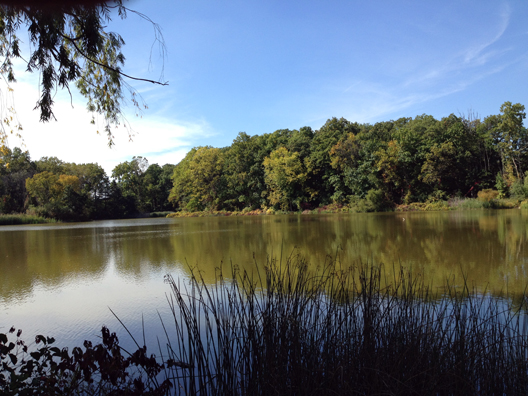by Marjorie Winkelman
PRAVEENA RAMASWAMI IS an enthusiastic, energetic woman with sparkling eyes and a streak of bright purple through her dark hair. She is the perfect tour guide at the Thurston Nature Center Fall work-day, greeting neighbors, activists, children and the Thurston Elementary School PTO president.
The enthusiasm is not Ramaswami’s alone. On Sept. 27, forty-five neighborhood families and a dozen volunteers from Toyota—about 100 people total—came out to clear brush, move mountains of wood chips, gravel, soil and lay the foundation for a new rain garden. The Nature Center sits adjacent to Thurston Elementary School and a neighborhood pool on the north side of Ann Arbor.
By all accounts this was the biggest turnout for the twice yearly work-day, a tradition that stretches back nearly 50 years. Mike Conboy and his wife Madeline have been at the forefront of the effort to care for the Nature Center since neighbors came together in 1967 to save the pond, a shining jewel in the middle of a subdivision, home to heron and turtles and surrounded by trees now tinged with Fall color. The Conboys planted the huge Weeping Willow next to the pond. On the work-day, a new generation of workers, kids, ducked under the boughs of the Weeping Willow, daring each other to climb higher and out over the water.

“The Nature Center has meant so much to so many,” said Mr. Conboy looking out toward a shrinking wood chip pile. “From the first school children who worked here in the 60s and were invited to the White House, to the neighbor who told me ‘this place saved my life.’ This place was his retreat from life’s pressures.”
Over the years, Mr. Conboy has worked with his neighbors in an effort to plant one specimen of every native Michigan tree. Thus far, 70 out of a list of 75 species are thriving on the property.
The pond, however, is not thriving. Fifty years of sediment has washed down into it, leaving the water shallow and under-oxygenated. The wildlife habitat cannot be maintained.
The Friends of Thurston Nature Center are not content to merely trim back overgrown brush and chip paths. Working with students at EMU and with the Watershed Council, they have come up with an ambitious $150,000 plan to dredge the pond to prevent flooding and improve water quality.
The Nature Center was designed to be an outdoor classroom adjacent to Thurston Elementary School. Students in all grades there will be a part of a Green-Steam project to build a rain garden. Spearheaded by Thurston PTO president (and former Detroit science teacher) Mary Manthey, the project is integrated into the curriculum at every grade level.
“Kindergartners will learn about mud, first gardeners will focus on inset life and second graders will choose a native species of frog for the new habitat.” said Manthey. “The rain garden will provide a breeding habitat for amphibians who will then migrate into the pond. The fifth graders will design and build a wind mill. We have worked closely with the school to integrate this project into the existing curriculum. Many teachers and the principal joined us at the work today.”
Other volunteers noted that this has not always been the case. The Nature Center and School, while sharing the same space, have not worked in conjunction in many years.
As Ms. Ramaswami walked around the grounds, neighborhood kids ran around, some helping with the project, some eating pizza provided by Toyota.
David Vallen was trimming back brush to allow more light to reach a young white pine.
“My dad is on the board of the Friends of the Nature Center” said Vallen. “I went to Thurston and Clague and now I am at U-M. I try to get back to these work days when I can.”
With the new William Stapp outdoor amphitheater inaugurated on Sunday and fundraising for the pond restoration begun, the preservation traditions of this neighborhood will go forward into a sixth decade. The question is not whether but which of the kids playing under the Willow tree planted by the Conboys will take over as stewards of the pond and paths in the decades to come.

